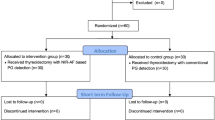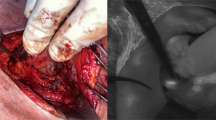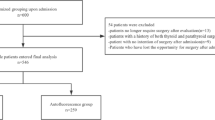Abstract
Purpose
The aim of this study is to describe the use of near-infrared autofluorescence (NIR-AF) to identify and preserve parathyroid glands (PGs) in a group of patients with advanced hypopharyngeal/laryngeal cancer undergone total (pharyngo)laryngectomy with hemi- or total thyroidectomy.
Methods
At San Raffaele Hospital, Milan (Italy), from January 2021 to May 2021, 7 patients affected by cT4a laryngeal squamous cell carcinoma (SCC) underwent surgery using an autofluorescence detection system (Fluobeam–Fluoptics®). For proper surgical planning, the demolition phase envisaged extension of the intervention to 4 hemithyroidectomies and 3 total thyroidectomies associated, respectively, with homolateral or bilateral CCND. Serum calcium, ionized calcium, and parathyroid hormone (PTH) levels at post-operative day (POD) 1 and 2 and at 2 weeks after surgery were monitored. Finally, we compared the data obtained with a cohort of patients who underwent surgery without the adoption of NIR-AF.
Results
With the use of NIR-AF, 18/20 PGs were identified, of which 7/18 were preserved exclusively thanks to the use of autoflorescence. The technique also made it possible to identify and isolate three PGs from the surgical specimen, which were subsequently transplanted only after intraoperative histological confirmation. On POD-1, 3/7 patients (42.8%) were hypocalcemic; on POD-2 and after 2 weeks only 1/7 patient (14.2%) was hypocalcemic. Comparing the two groups, we highlighted that the utilization of NIR-AF was related to a significant decrease of median serum (p = 0.026) and ionized calcium levels (p = 0.017) 2 weeks after surgery. Using this new technology, in no case did definitive histological examination reveal the presence of PGs in the surgical specimen, reaching an accuracy of 100%.
Conclusions
In our cohort of patients who underwent total (pharyngo)laryngectomy with hemi- or total thyroidectomy, the use of near-infrared autofluorescence improved medium term postoperative hypocalcemia rates. This new technology helps to achieve a better calcemic outcome compared to the standard naked eye approach, since it helps the surgeon to identify and preserve parathyroid glandular tissue with a lower incidence of post-operative hypocalcemia.



Similar content being viewed by others
References
Medina JE, Ferlito A, Robbins KT, Silver CE, Rodrigo JP, de Bree R, Rinaldo A, Elsheikh MN, Weber RS, Werner JA (2011) Central compartment dissection in laryngeal cancer. Head Neck 33(5):746–752. https://doi.org/10.1002/hed.21453
Gorphe P, Ben Lakhdar A, Tao Y, Breuskin I, Janot F, Temam S (2015) Evidence-based management of the thyroid gland during a total laryngectomy. Laryngoscope 125(10):2317–2322. https://doi.org/10.1002/lary.25417
Sparano A, Chernock R, Laccourreye O, Weinstein G, Feldman M (2005) Predictors of thyroid gland invasion in glottic squamous cell carcinoma. Laryngoscope 115(7):1247–1250. https://doi.org/10.1097/01.MLG.0000165454.75480.EA
Geminiani M, Aimoni C, Scanelli G, Pastore A (2007) Parathyroid function study in patients submitted to laryngeal surgery for squamous cell carcinoma. Acta Otorhinolaryngol 27(3):123–125
Lo Galbo AM, Kuik DJ, Lips P, von Blomberg BME, Bloemena E, Leemans CR, deBree R (2013) A prospective longitudinal study on endocrine dysfunction following treatment of laryngeal or hypopharyngeal carcinoma. Oral Oncol 49(9):950–955. https://doi.org/10.1016/j.oraloncology.2013.03.450
Hannan FM, Thakker RV (2013) Investigating hypocalcaemia. BMJ 9(346):f2213. https://doi.org/10.1136/bmj.f2213
Barbieri D, Indelicato P, Vinciguerra A, Marco F, Formenti AM, Trimarchi M, Bussi M (2020) Autofluorescence and indocyanine green in thyroid surgery: a systematic review and meta analysis. Laryngoscope. https://doi.org/10.1002/lary.29297
Barbieri D, Triponez F, Indelicato P, Vinciguerra A, Trimarchi M, Bussi M (2021) Total thyroidectomy with intraoperative neural monitoring and near-infrared fluorescence imaging. Langenbeck’s Arch Surg. https://doi.org/10.1007/s00423-021-02228-3
National Comprehensive Cancer Network, Guidelines. Head and Neck Cancers (Version 3.2021). https://www.nccn.org/professionals/physician_gls/pdf/head-and-neck.pdf. Accessed December 20, 2021
Edafe O, Sandler LM, Beasley N, Balasubramanian SP (2020) Systematic review of incidence, risk factors, prevention and treatment of post-laryngectomy hypoparathyroidism. Eur Arch Otorhinolaryngol. https://doi.org/10.1007/s00405-020-06213-2
Osborn DA, Jones WI (1968) Parathyroid dysfunction following surgery of the pharynx and larynx. Br J Surg 55(4):277–282. https://doi.org/10.1002/bjs.1800550410
Basheeth N, O’Cathain E, O’Leary G, Sheahan P (2014) Hypocalcemia after total laryngectomy. Laryngoscope 124(5):1128–1133. https://doi.org/10.1002/lary.24429
Rosato L, Avenia N, Bernante P et al (2004) Complications of thyroid surgery: analysis of a multicentric study on 14,934 patients operated on in Italy over 5 years. World J Surg 28:271–276
Edafe O, Antakia R, Laskar N, Uttley L, Balasubramanian SP (2014) Systematic review and meta-analysis of predictors of post-thyroidectomy hypocalcemia. Br J Surg 101:307–320
Lerchenberger M, Al Arabi N, Gallwas JKS, Stepp H, Hallfeldt KKJ, Ladurner R (2019) Intraoperative near-infrared autofluorescence and Indocyanine green imaging to identify parathyroid glands: a comparison. Int J Endocrinol 2019:4687951
Funding
The authors received no financial support for the research, authorship, and/or publication of this article.
Author information
Authors and Affiliations
Corresponding author
Ethics declarations
Conflict of interest
The authors declare no potential conflicts of interest with respect to the research, authorship, and/or publication of this article.
Additional information
Publisher's Note
Springer Nature remains neutral with regard to jurisdictional claims in published maps and institutional affiliations.
Rights and permissions
Springer Nature or its licensor holds exclusive rights to this article under a publishing agreement with the author(s) or other rightsholder(s); author self-archiving of the accepted manuscript version of this article is solely governed by the terms of such publishing agreement and applicable law.
About this article
Cite this article
Barbieri, D., Melegatti, M.N., Vinciguerra, A. et al. The use of near-infrared autofluorescence during total laryngectomy with hemi- or total thyroidectomy. Eur Arch Otorhinolaryngol 280, 365–371 (2023). https://doi.org/10.1007/s00405-022-07584-4
Received:
Accepted:
Published:
Issue Date:
DOI: https://doi.org/10.1007/s00405-022-07584-4




